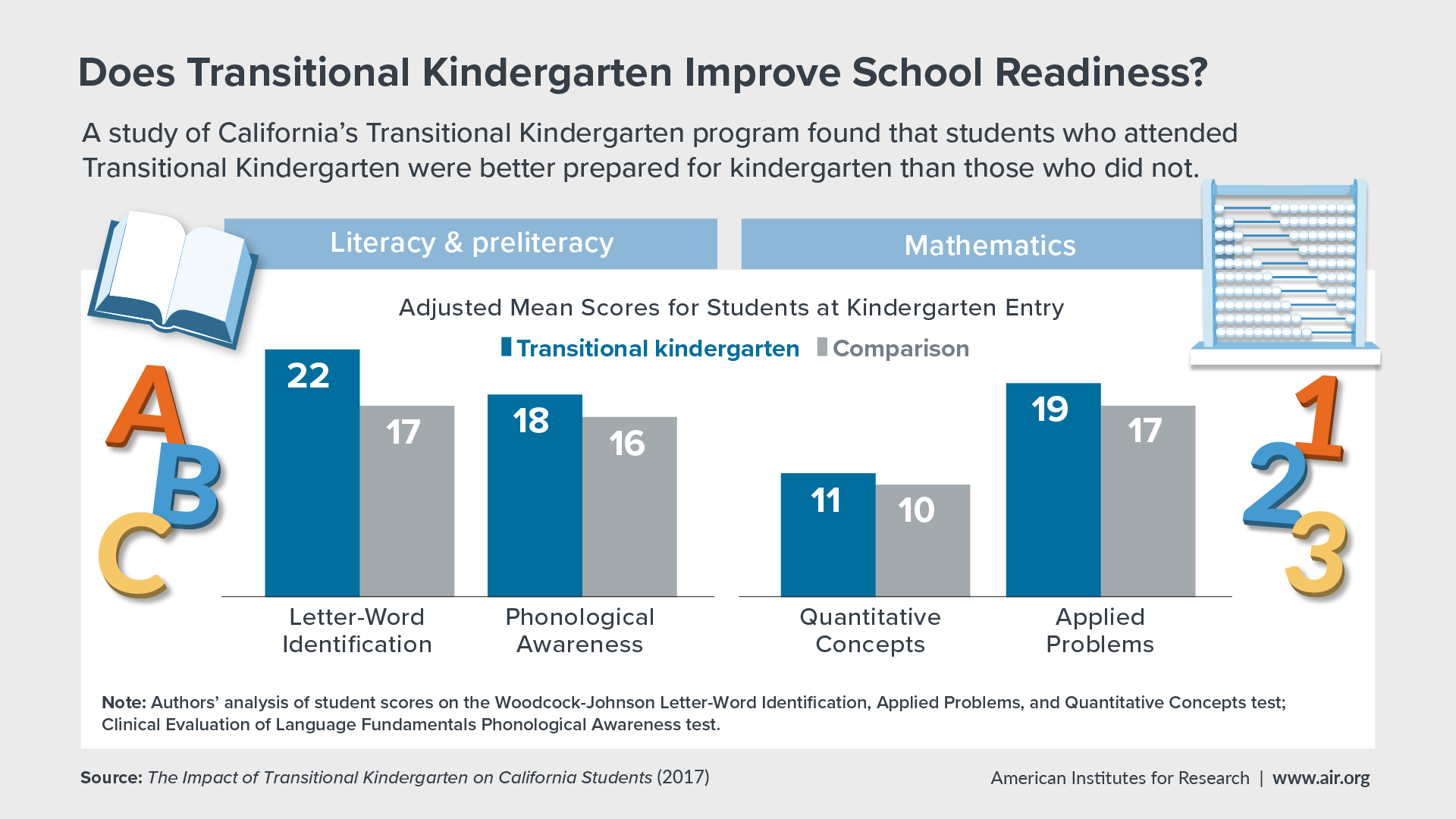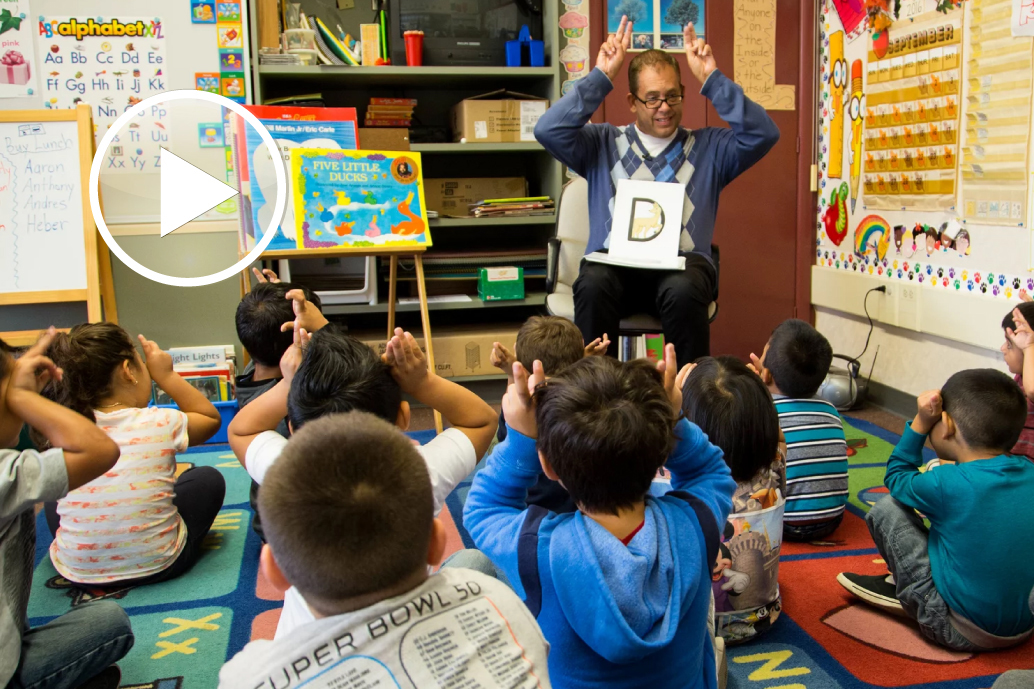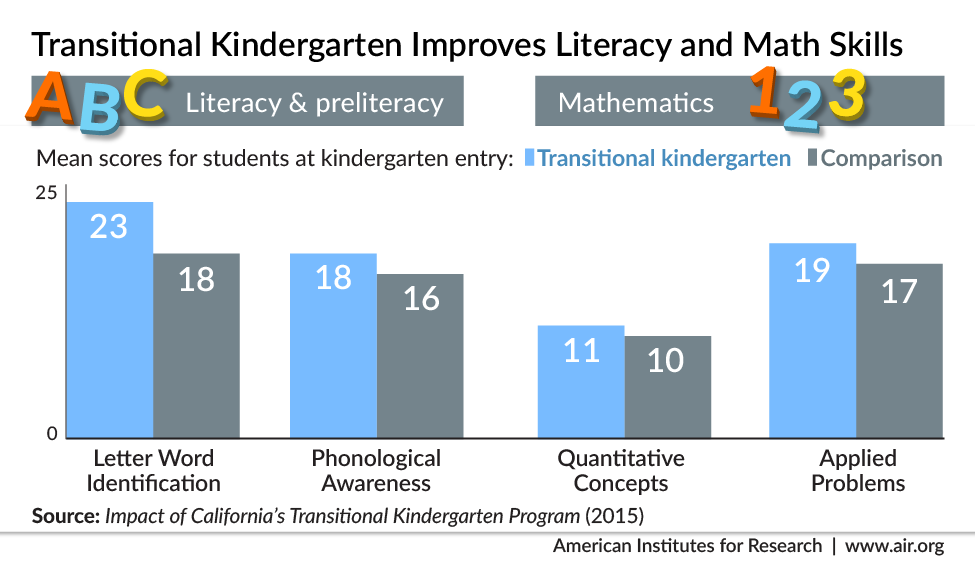Study of California's Transitional Kindergarten Program
Created in 2010 by the Kindergarten Readiness Act, transitional kindergarten (TK) offers younger children in California additional time to prepare for school. TK is the first year of a two-year kindergarten experience and provides an additional year of early education to thousands of children each year, with the goal of promoting their school readiness.
Supported by its partners, the Heising-Simons Foundation, the David and Lucile Packard Foundation, and First 5 California, AIR completed a study of the impact of transitional kindergarten in California on children’s academic and social-emotional skills in kindergarten, and how these impacts are related to program quality characteristics.

Final Report: The Impact of Transitional Kindergarten on California Students (June 2017)
Watch a webinar recording describing the findings.
View the research brief/summary of findings.
This final report from the program’s evaluation focuses on results from a five-year study. The study used a rigorous regression discontinuity design to examine whether TK leads to positive outcomes, for which students, and under what conditions. The findings are based on direct assessments of over 6,000 kindergarteners in California in the fall and spring of the 2014-15 and 2015-16 school years, surveys of their teachers, and statewide data on students’ English language proficiency.
Key findings:

Video: A transitional kindergarten teacher describes his work with his young students, and Karen Manship describes how the program helps ensure children receive a strong start to their educational careers.
Watch on YouTube.
- TK gives students an advantage at kindergarten entry on a range of literacy and mathematics skills. TK students were also rated as more engaged by their teachers, compared to their peers.
- TK is effective for all groups of students who participated. It showed a particularly notable impact on language skills for English learners and mathematics skills for low-income students at kindergarten entry.
- TK has no detectable impact on students’ executive function or incidence of problem behaviors at kindergarten entry.
- Impacts of TK are smaller at the end of kindergarten, though TK students continue to have an advantage over non-TK students on letter and word identification skills. Overall, non-TK students appeared to catch up with their TK peers on most measures, although both TK and comparison students demonstrated growth at or above what would be expected for their age on several assessments. The impact of TK on the literacy and mathematics skills of low-income and Hispanic students also persisted through kindergarten.
- There was little variation in the impact of TK by classroom or instructional characteristics. Standalone classrooms were not significantly different from TK/kindergarten combination classrooms in their impact; half-day and full-day classrooms showed similar effects; and differences in assessed quality of teacher-child interactions did not change the program’s impact. These findings suggest TK’s positive impact for students may be driven by the characteristics that TK programs have in common: credentialed teachers with bachelor’s degrees, close alignment with kindergarten, and inclusion of students from all income-levels.
Additional Reports (PDF)
The Impact of Transitional Kindergarten on English Learner Students (May 2017)
This brief summarizes what we have learned about the impact of TK on English Learner (EL) students’ school readiness skills, including mathematics skills, language and literacy skills, and English proficiency.
What Do Transitional Kindergarten Classrooms Look Like in the Third Year of the Program’s Implementation? (June 2016)
This short report focuses on what we learned about the structure, teachers, and instruction in TK classrooms in the 2014–15 school year.
Impact of California's Transitional Kindergarten Program, 2013-14 (December 2015)
Key findings from 2013-14 indicated that TK improves preliteracy and literacy skills, and mathematical knowledge and problem-solving skills. An accompanying brief, The Impact of Transitional Kindergarten on Kindergarten Readiness, outlines the results of this report and suggests next steps for further research.
 Transitional Kindergarten in California: Early Outreach, Enrollment, and Parent Perspectives (March 2015)
Transitional Kindergarten in California: Early Outreach, Enrollment, and Parent Perspectives (March 2015)
This brief investigating TK implementation in Year 1 focuses on district outreach efforts, parent perceptions of TK, and TK student demographics.
Transitional Kindergarten in California: Comparing Transitional Kindergarten and Kindergarten Classrooms (October 2014)
Early on, the rollout of the Act gave rise to questions about how TK is being implemented in districts throughout California. This research brief focuses on characteristics of transitional kindergarten classrooms compared with those of kindergarten classrooms.
Study of California’s Transitional Kindergarten Program: Report on the First Year of Implementation (April 2014)
A study looking at the first year of transitional kindergarten in California found that most districts implemented the new grade level, and that approaches varied widely. View an executive summary of the findings (PDF).
Transitional Kindergarten in California: A Review of the First Year (June 2013)
This research brief focuses on describing the landscape of California’s TK program in its first year of implementation.

Expanding California's Transitional Kindergarten Program
In July of 2021, Governor Gavin Newsom signed the TK-12 Education Trailer Bill (AB 130), which expanded eligibility in TK programs to serve all 4-year-old children by 2025-26. Given the current teacher shortage and the swift ramp-up required under the legislation, TK expansion has the potential to pose a significant workforce challenge, both for teacher preparation programs training future educators as well as districts and schools hiring TK teachers. There has also been a renewed emphasis on the needs of dual language learners (DLLs) in California, who make up more than half of children 0–5 in California and may benefit from TK expansion.
Building off prior studies of the impacts of TK, AIR conducted three exploratory studies to understand how TK is being expanded across the state and to identify needs and strategies to support successful expansion and effective learning opportunities for eligible children, including DLLs.
Assessing the Capacity of Teacher Preparation Programs to Support TK Expansion (March 2024)
The first study focused on understanding the capacity of the TK teacher preparation and credentialing system to train new TK teachers. We aimed to understand the capacity of existing programs to meet workforce demands, their plans for expansion, their approaches to recruiting and training a diverse and representative teacher workforce, and any ways that programs prepared their candidates to teach in diverse and multilingual classrooms.
Key findings:
- Existing Multiple Subject Credential teacher preparation programs estimated small increases in their capacity between the 2021–22 school year and the 2023–24 school year, but likely not enough to account for the number of TK teachers needed for the expansion.
- Based on these projections and previous estimates of new TK teachers needed, we find that the number of new TK teachers needed each year represents between one quarter and one half of ALL new candidates graduating from Multiple Subject Credential programs.
- Many programs did not have enough faculty and staff with experience in early childhood to teach the required ECE-focused courses or build a PK–3 credential.
- Although programs reported numerous efforts to engage diverse candidates, including those with ECE teaching backgrounds, many respondents expressed concerns about the accessibility of existing programs for ECE teachers who are currently in the workforce.
Examining TK Staffing Challenges and Solutions at the Local Level (March 2024)
TK expansion poses a significant workforce challenge for school districts throughout the state. This qualitative study described how districts and schools are currently staffing TK classrooms and building the TK pipeline to address future needs, the contexts and constraints under which they operate, and the supports and stop-gap and long-term common and unique solutions used to address these constraints. AIR also identified a list of promising strategies to support the work of district and school leaders to expand TK, including:
- Recruit TK teaching staff throughout the year.
- Actively collaborate with other districts, preschools, high schools, and other local organizations to build the pipeline of future TK teachers.
- Support TK teachers to ensure retention.
- Take a systemwide approach to expanding TK.
Identifying Resources and Supports Needed in TK Classrooms to Support Learning for DLLs (March 2024)
The goal of this study was to explore how TK teachers use strategies to support DLLs in their classrooms, what resources and supports are available to them to maximize learning opportunities for DLLs, and what additional resources are needed. We describe teachers’ perspectives and practices in TK classrooms to support 4- and 5-year-olds broadly as well as their DLLs. Specifically, the study team conducted teacher interviews and classroom observations in a small sample of TK classrooms across the state.
Key findings:
- Most teachers in our sample felt confident about teaching TK but wanted additional training, supports, and resources specific to TK, including professional development, curricula, and materials.
- The TK teachers in this sample provided developmentally appropriate instruction in terms of the activities, settings, and classroom layouts observed.
- The Spanish dual language immersion TK programs observed for the study provided rich exposure to Spanish in both instruction and materials, and teachers in non-dual language immersion classrooms also integrated occasional Spanish support, though they had fewer classroom environment materials in Spanish.
- There were many different home languages represented by the TK students across the sampled classrooms, but home language support by TK teachers occurred only in Spanish (and in Vietnamese in the Vietnamese dual language immersion program).


